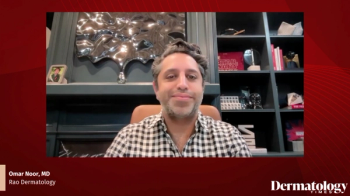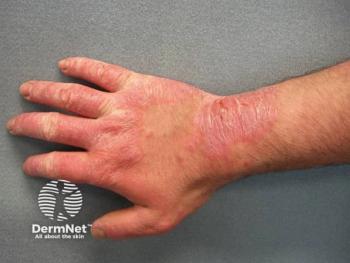
Q&A: Celebrating the First Annual GPP Awareness Day
Key Takeaways
- GPP Awareness Day aims to improve recognition and understanding of generalized pustular psoriasis, a rare and life-threatening condition often misdiagnosed.
- Diagnostic challenges arise from GPP's rarity, complex presentation, and confusion with other skin conditions, necessitating thorough history and clinical evaluation.
Shannon C. Trotter, DO, FAOCD, FAAD, and patient Janene Tirado, highlight GPP Awareness Day and the urgent need for recognition and understanding of generalized pustular psoriasis.
Today, August 13, 2025, the dermatology world is recognizing the first-ever GPP Awareness Day, a new initiative dedicated to spotlighting generalized pustular psoriasis. GPP is a rare, life-threatening inflammatory skin disease that remains underrecognized and frequently misdiagnosed.
To mark this important day, Dermatology Times spoke to Shannon C. Trotter, DO, FAOCD, FAAD, a board-certified dermatologist at DOCS Dermatology in Columbus, Ohio, and Janene Tirado, a patient from Utica, New York, who struggled with an initial misdiagnosis of GPP in 2020. Trotter and Tirado highlight the real-world impact of diagnostic delays and the urgent need for greater clinical awareness.
Q&A with Shannon C. Trotter, DO, FAOCD, FAAD
DT: Why do you personally believe it is so important to have a day dedicated to raising GPP awareness?
Trotter: A GPP Awareness Day is so important because it demonstrates how we are finally giving GPP the attention it deserves. A dedicated day honors patients who have GPP and tells them that their journey and experience matter. A GPP Awareness Day will also educate dermatologists and other providers on the challenges surrounding the diagnosis of GPP and give updates with advances in treatment.
DT: What makes the diagnostic process of GPP so complex? What advice do you have for dermatologists who may be seeing these challenging cases in clinic?
Trotter: The diagnostic process of GPP is complex for 3 main reasons. One, with only 1 out of 10,000 Americans with GPP, it is a rare condition and may not be on a provider’s radar. Two, GPP is often only thought of in its acute flare form, and as a result, the other stages, such as the prepustular phase, may go unrecognized for years. And three, some dermatologists think of GPP as a variant of plaque psoriasis and mistakenly lump the two entities together, when they are distinct skin conditions with different pathophysiology and treatment needs. In addition to plaque psoriasis, GPP might also be confused with palmar plantar pustulosis, acute generalized exanthematous pustulosis (AGEP), subcorneal pustular dermatosis (Sneddon-Wilkinson disease), or IgA pemphigus. When faced with a possible GPP case in clinic, a thorough history and a skin biopsy can be helpful to distinguish between GPP and mimickers. There are established criteria to help as well. However, because GPP is an emergent diagnosis, you can’t really wait for biopsy results so history, clinical findings, and an index of suspicion are essential.
DT: From a research perspective, what are the most pressing questions that still need to be answered about GPP?
Trotter: One of the greatest challenges is identifying those who might be at risk for developing GPP. The role of biomarkers or genetic testing, like IR36RN, is also an area for more research, especially with the diagnosis of GPP in a prepustular phase. Currently, we have 1 FDA-approved therapy that blocks IL-36 and additional targeted therapies are on the horizon. Future studies should focus on how arthritis associated with GPP or psoriatic arthritis is impacted by IL-36 therapies as monotherapy or in combination with other targeted treatments. Furthermore, we need more data on how to treat both plaque psoriasis and GPP simultaneously, with different biologic targets, to evaluate efficacy and safety.
My goal is for dermatologists to understand that GPP is a life-threatening emergency. It’s what I call a 911 skin diagnosis, so a rapid diagnosis and treatment are paramount. In addition, I want dermatologists to regard GPP like any other chronic condition in dermatology. Many of us treat the acute or emergent phase, but don’t address the post-flare phase aggressively. During a post-flare phase, patients can experience skin symptoms like redness, scaling, and debilitating anxiety about when the next flare might occur. We’ve raised the bar for atopic dermatitis and psoriasis and now it’s time for GPP. We would never treat psoriasis until it cleared, stop treatment and then wait for it to flare again. We need to approach GPP in the same manner, and now we have a safe, FDA-approved therapy to do so. Dermatologists should treat a GPP flare and then transition to maintenance therapy for the post-flare phase. Effectively treating GPP means treating both the acute and chronic nature of the disease. We need to improve our patients’ quality of life and empower them to control their GPP so that it doesn’t control them.
DT: How do you hope this year’s GPP Day will impact the medical community, any multidisciplinary specialists, and our audience of dermatologists?
Trotter: I hope this year’s GPP Day will serve as a springboard to start discussions about GPP in the medical community and across specialties. Maybe it’s a plastic surgeon who clicks on a GPP article out of curiosity and learns something new. Perhaps it’s a rheumatologist that prescribed systemic steroids to a psoriatic arthritis patient who now has a diffuse, painful pustular rash and wonders if it could be GPP. Maybe it’s the ED doctor who recalled a severe eruption a few months ago that looked like the worst case of psoriasis he’s ever seen and now thinks, GPP? The win--GPP will be a consideration where it never was before.
For the dermatologist, my hope is that GPP Awareness Day will deepen our understanding of GPP, from the heterogeneous clinical presentation and chronic nature to diagnosis and treatment. For the dermatologist who hasn’t considered maintenance therapy, now maybe they will. For the dermatologist that didn’t ask about how having GPP impacts quality of life, creates anxiety or produces skin symptoms beyond a flare, now they might inquire more. And while the clinic day might be dominated by acne or skin checks or Botox, now dermatologists will remember that GPP will likely walk through the door at some point. GPP Awareness Day will remind dermatologists of that possibility and so we will be ready to take it on.
DT: After this day, what are the next steps in raising awareness and improving care for GPP patients?
Trotter: The next steps focus on continuing the conversation. A day in the spotlight is useful but only if the light continues to shine on. If you have a case of GPP, please share it with your colleagues, whether they are dermatologists or another specialty, and review your path to diagnosis and process for treatment. Encourage your patients to share their stories and become active in advocacy.
Always remember that as dermatologists, we are the skin experts. While there’s value in educating emergency room physicians, family physicians, and other providers about GPP, the primary responsibility lies with us to make an accurate diagnosis and initiate therapy. As dermatologists, we are often put in a unique position to help patients with a condition that our colleagues have never heard of or never seen before. GPP is a great example of this reality and the value we bring as dermatologists to the table of medicine.
Q&A with Janene Tirado
DT: You experienced a sudden, full-body flare that was initially misdiagnosed in the ER. Can you walk through what that flare looked like, and how long it took before you received an accurate diagnosis of GPP?
Tirado: It all started in August 2020. I was getting ready for a golf tournament my husband was playing in, and I noticed 2 red patches on my right foot. I have plaque psoriasis, so I’m used to seeing spots on my skin — but these looked different. A few hours later, there were six patches, my foot was swollen, and it felt like it was on fire. By the time we got to the ER, I was nauseous, sweating, and another blister had popped up on my other foot. The doctor took a picture and sent it to colleagues, then came back and said it was athlete’s foot. They gave me cream and sent me home — even though I had a fever and the rash was spreading. By late that night, both feet were covered in pustules, and they were moving up my legs. I was shaking, blacking out, and in so much pain I couldn’t touch my feet. The next morning, I called my dermatologist’s emergency line. When I finally saw him, I could barely walk into the office. He took one look and said, “She’s got a long road. She has pustular psoriasis.” That was the first time I’d ever heard of GPP.
DT: What kind of language or responses did you hear from health care providers early on, and in hindsight, what do you wish they had recognized or done differently?
Tirado: In the ER, I could tell they didn’t know what they were looking at. The questions felt random — like asking if I’d eaten something I was allergic to — and the diagnosis of athlete’s foot just didn’t make sense. They didn’t connect my fever, nausea, and the speed of the rash with something more serious. Looking back, I wish they had recognized how urgent it was and sent me straight to a dermatologist. GPP can get dangerous really fast. Listening to patients and taking their symptoms seriously could save a lot of time, pain, and maybe even lives.
DT: How did living with undiagnosed GPP impact your physical and mental health? What changed once you were correctly diagnosed and began receiving treatment?
Tirado: Even though I was only undiagnosed for a few days, it was terrifying. Physically, I felt like I was walking on fire. I couldn’t wear shoes, couldn’t stand up for long, and the fever just wouldn’t break. Mentally, I felt isolated and scared — I didn’t recognize my own body. My skin was covered in pustules, I lost all my toenails, and I kept thinking, Will I ever look normal again? Once I was diagnosed, my dermatologist was calm but honest. He told me it would be a long road, but I would get better. That gave me hope. He started me on crisis meds, then a biologic, and little by little, I started to heal. Having a name for what I was going through made me feel less alone and more in control.
DT: Were there any care team members who stood out in your journey? What did they do that made a difference?
Tirado: Yes, a few people truly stood out. My dermatologist recognized the urgency of my condition and diagnosed me quickly. He still treats me today, and I’m so grateful for his knowledge of GPP. The nurses at his office also made a huge difference. They listened, showed compassion, called to check on me at home, and even taught me how to give myself my biologic injections. And of course, my husband — he was my rock through it all.
DT: What advice would you give to dermatologists and other providers who may be unfamiliar with GPP, especially when it comes to listening to patients and recognizing red flags?
Tirado: GPP is very different from plaque psoriasis, and there’s far less awareness about it. The lack of knowledge can be life-threatening. My advice? Listen to your patients. If someone says their symptoms are spreading fast, they have a fever, or they’re in extreme pain, don’t brush it off. Act quickly and get them to a dermatologist. The sooner GPP is recognized, the better the outcome. For anyone who wants to learn more — whether you’re a provider, a patient, or a caregiver — I recommend checking out
Newsletter
Like what you’re reading? Subscribe to Dermatology Times for weekly updates on therapies, innovations, and real-world practice tips.



















